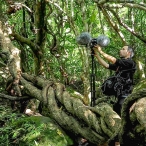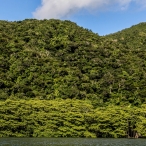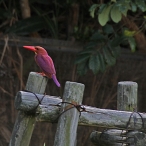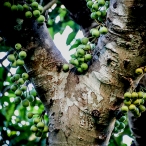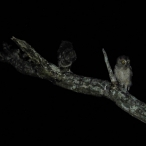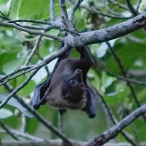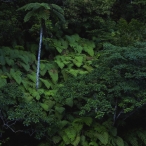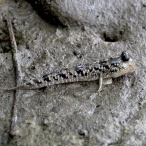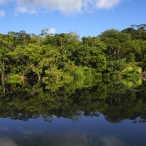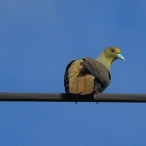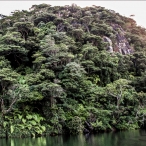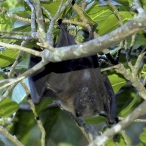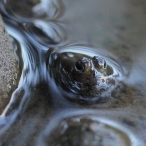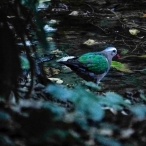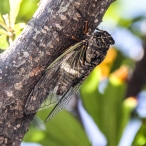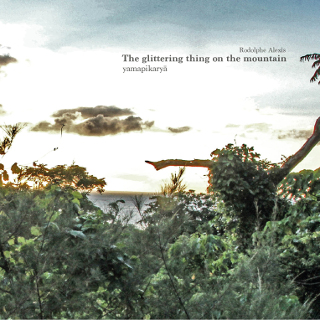
The glittering thing on the mountain | Rodolphe ALEXIS
Gruen 158 | Audio CD (+ Multichannel Digital) > [Sold Out]
Field recordings from Japan’s last frontier Iriomote Jima
Reviews
Based in the Okinawa Prefecture and former part of the Yaeyama archipelago and Ryukyus islands, Iriomote-Jima is the most southern island in Japan and 90% of it ground is covered by jungle and mangrove.
Even during its short period of coal mining, the island was never inhabited by a large human population, mainly because of Malaria, as a result its natural environment and wildlife were preserved. Malaria- free, Iriomote was only returned to Japan by the US in 1972.
This land is home to many local species including insects, frogs and birds, but also flying foxes and the famous leopard cat named Yamaneko, which was only discovered in 1965.
A local legend says another mysterious big cat allegedly lived on the island and was much larger than the Yamaneko. At night, his eyes were said to be the glittering thing on the mountain or Yamapikaryā. Some people even claim this creature still exists.
In the spring of 2009, I found myself by chance just a few hours away, by boat, from this last frontier of Japan, but had no means to get there.
I promised myself to return there, even for short span, but with my recording equipment. This finally became possible in the summer of 2014 and I went there with a four-channel microphone setup.
This work was produced with the help of the Tropical Biosphere Research Center University of the Ryukyus. It was premiered in the auditorium of the Museum national d’Histoire naturelle, in Paris, and a special piece was derived from it for Touch Radio #104.
Acknowledgments :
DinhaBird, Yuko & Sam Bird, Yoko Fukushima, Mike Harding, Benoît Hické, Trevor Jones, Takafusa Morimoto, François Vaillant, Valérie Vivancos, Shin Watanabe
Tracklisting
1 – Cicada of the dusk – 6’53
feat. Taiwan higurashi (Pomponia yayeyamana) and megabat’s wings.
2 – The hill was sinking into the night, some frogs were playing the harp – 13’48
feat. rubber sounds of Harpist brown frog (Rana psaltes), Eiffinger tree frog (Kurixalus effingeri), Ryūkyū scops owl (Otus elegans) including adults
songs and the calls of their chicks perched nearby.
MP3
3 – Rice field interlude – 1’42
feat. ending chorus of Sakishima rice frog (Ferjervarya sakishimensis).
4 – Megabats party in the backyard – 7’23
feat. Ryūkyū flying foxes (Pteropus dasymallus) training their youngs around a tree, then lonely calls of a Sakishima rice frog resonates in a water
pipe.
MP3
5 – Morning whispers, Urauchi River – 4’42
feat. Emerald dove (Chalcophaps indica) in the background, noisy high-pitched cries of Brown-eared bulbul (Hypsipetes amaurotis) and liquid
echoes of Ruddy kingfishers (Halcyon coromanda bangsi).
MP3
6 – Chatting around midday – 2’53
feat. Ryūkyū green-pigeon (Treron permagnus) in the background and Ryūkyū jungle crow (Corvus macrorhynchos connectens) conversations.
7 – Gentle breeze on the forest edge interlude – 1’41
feat. Ryūkyū green-pigeon and Ryūkyū crested serpent eagle (Spilornis cheela perplexus).
MP3
8 – Early morning for Mudskippers – 3’30
feat. morning chat of White-breasted waterhen (Amaurornis phoenicurus), and tiny song of Japanese white-eye (Zosterops japonicus loochooensis),
and a cicada (Platypleura kaempferi) in the background.
9 – Night’s Calling – 8’26
feat. Northern boobook (Ninox japonica), Ryūkyū scops owl, high pitched sounds ‘maracas-like’ of Eiffinger tree frog, Ryūkyū scops owl, Ryūkyū
kajika frog (Buegeria japonica) and the repetitive calls of White-breasted waterhen.
MP3
9 Tracks (48′58″)
CD (500 copies) + Multichannel Digital
Recorded in July 2014.
Edit, Mastering, Artwork : Rodolphe Alexis
Multichannel Digital : This track is a special edit of Iriomote’s ambiances recorded with a quadraphonic „IRT cross“ setup. The best configuration to listen to it, is to reproduce a square with speakers in each corner of your room with in between each of them an angle of at 90°.
Field Recording Series by Gruenrekorder
Germany / 2015 / Gruen 158 / LC 09488 / SACEM / EAN 4050486946787
Photos captions :
01 Iriomote detail
02 Ruddy kingfisher
03 Fruts For Bats
04 Ryukyu scops owl
05 Ryukyu flying fox
06 Iriomote detail
07 Barred Mudskipper
08 Japanese white eye
09 Sakishima rice frog
10 Urauchi River
11 Ryukyu green pigeon
12 Iriomote detail
13 Ryukyu flying fox
14 Barred Mudskipper
15 Emerald dove
16 Cryptotympana yayeyamana
17 Biological research station
18 Quadraphonic setup
All photos : Shin Watanabe
except 02, 07,12, 16, 17 : Rodolphe Alexis
Nowamuzyka’s list of 58 favorite albums of the world – 2016
Among these:
– Mikel R. Nieto – „Dark Sound” (Gruenrekorder)
– Rodolphe Alexis – „The glittering thing on the mountain” (Gruenrekorder)
Roger Batty | Musique Machine
The Glittering Thing On The Mountain brings together a selection of fascinating, beautifully recorded, and varied field recordings made in one of the more remote & untouched jungles of Japan.
This CD release appears on German label Gruenrekorder-one of the most respected & consistently quality bound field recording/ sound art label around. As expected from this label, the CD packaging is thoughtful conceived and beautiful illustrated. It takes in a full colour digipak, which on the front takes in a beautiful landscape picture of untouched & dense jungle vista. Also featured is a 12 page inlay booklet- this is also full colour taking in a selection of wildlife pictures, jungle landscapes, overhead shots, and a page of text outline the releases themes.
All the recordings featured here where captured in the summer of 2014 on Iriomote-Jima- which is southern most island off the coast of Japan. 90% of the island is covered by jungle and mangrove, and it has never really been inhabited by a large human population- so both the wildlife & their habitat has remained mostly untouched by man.
The recordings where captured by Frenchman Rodolphe Alexis- who is field/sound recordist, sound artist and designer. He has been releasing/ creating work since the early 2000’s. And The Glittering Thing On The Mountain is his third full-length release for Gruenrekorder.
The CD features nine tracks & a total running time of fifty one minutes. The nine tracks have running times between one & nearing fourteen minutes. And each track is equal in both its crystal clear recording definition & interesting/ distinctive sound capture. With Alexis artful managing to cut the recordings at just the right moment, so you get enough of the sounds to fascinate & sooth, yet they never outstay their welcome- which of course is key to a great sound recordist.
The tracks offer up a mix of bird, insect, frog, & bat recordings, with sometimes the backdrop of water recordings appearing from the streams that make their way through the islands greenery. These recordings were captured at different times of day, so you also get the nice mix of type of sound activity in the jungle. From the dense yet subdued simmer of the night-time jungle, through to the bright chirp & awaking of the mourning, on to the more vibrate & chatting interplay of the daytime.
In summing-up The Glittering Thing On The Mountain is another well presented & conceived collection of field recordings from the Gruenrekorder label. It’s a release that mangers to whisk one off on sonically rich & often unique sound journey- that’s both soothing, beautiful and at times quite alien.
link
Gunter Heidegger | The Sound Projector
The work of French-speaking sound artist Rodolphe Alexis has been previously documented in The Sound Projector; his contribution to the duo OttoannA’s ‘cohesive and varied – if hardly electrifying – sound-art soup’ Federated States of Micronesia provided our reviewer with some diverting hours of listening. However, while the many field recordings under his name remain largely unknown to us, little guesswork is needed to form an idea of his product, so long as this captivating natural survey is representative.
Fulfilling a personal vow in July 2014, Alexis took his recording equipment to Iriomote-Jima, the southernmost island of Japan and a former coal-mining area, where jungle covers 90% of the ground and the Tropical Biosphere Research Centre (and its accompanying roads) is one of the few signs of human presence. Home to many distinctively Japanese species of wildlife including the ‘famous leopard cat named Yamaneko’ (mountain cat), local legend alludes to the existence a larger feline variant whose eyes are known as ‘the glittering thing on the mountain’; a phenomenon that lends this CD its name. Which community begat this testimony is not stated, nor is the cat itself scientifically documented, but so equally menacing and mysterious is the image that it was chosen to contextualise Alexis’ document. To my ears however, only the latter aspect is strongly in evidence.
Which is not to castigate Mr. Alexis, for this is an achievement in itself. An enviable slew of international residencies and a steady stream of soundtrack work for nature documentaries suggest that cohesiveness and reliability are as much Alexis’ stock-in-trade as his modest arsenal of high-end microphones. He is methodical and curious about his environments and what exists beneath the false veneer evident only to the dull and over-gratified human senses. He does not seek to overwhelm, only to portray nature’s beautiful equilibrium as clearly as we might be permitted to appreciate in an appropriately receptive state, and from there to establish the less evident connections with our more ‘civilised’ realm.
Thus it appears in the opening chorus of cicadas whirring at dusk, whose electrifying harmony is periodically punctuated by a renegade wave of a more vociferous individuals in the same way that an otherwise serene electric composition can be momentarily uplifted by a distortive event. This feat is not a one off and is repeated by a chorus of brown and tree frogs in the second track; their song overlaid by an owl’s staccato chirping to its young, and reminding that even in environments we might suppose to be ‘idyllic’, the perennial conflict of interest between mass and individual is maintained at full-strength; each offering the other potential for new and fruitful new directions of development.
Is it from such balance that our composers and artists draw inspiration? Or do such influences permeate our actions on an unconscious level so that our works exhibit its traits in manifold yet ultimately identifiable ways? And from where has man acquired the notion that he is somehow distinct from these forces?
Such lines of enquiry open to me as I bathe in the steady waves of sound brought about by calm winds, the cawing, twittering avian multitudes, splitting/sploshing mudskippers, the river’s early morning whispers and even the screeching of a ‘Megabits party in the backyard’. Indeed, if Alexis’ recordings are to be believed, one might experience a level of enveloping comfort in the early outposts of nature’s own unspoilt territory, and recognise that nature’s equilibrium is our true home.
But we know this to be a falsehood: mother nature, while beautiful, is also merciless and even from the other side of the speaker, we must be aware of the level of personal discomfort that Mr. Alexis experienced while capturing these exotic and intriguing recordings. Such is the inherent beauty and mystery of the accompanying photography that we may wish to have accompanied him. And thus we might remember that within us all there lingers a hushed desire to experience life ‘on the wild side’.
link
Guillermo Escudero | Loop
This is the third work on the German Gruenrekorder imprint [‘Sempervirent’, 2012 and “Morne Diablotins”, 2014] of Rodolphe Alexis, sound artist and French designer who lives and works in Paris. His work is based on field recordings, electroacoustic composition, radio parts and specific sites for installations or presentations.
In 2009 Alexis was a few hours away by boat from the southernmost island of Japan, Iriomote-Jima, part of Okinawa Prefecture and former part of Yaeyama archipelago and Ryukyus Islands. At that time he didn’t have no means to get there, therefore promises to come back.
In 2014 he went there with a four-channel microphone setup.
In this island live many species, including insects, frogs and birds, but flying bats and the famous leopard cat named Yamaneko, which was only discovered in 1965.
90% of the island is covered by jungle and mangroves and in this environment in summer season, Alexis pointed his microphone to pick up a huge variety of insects, birds, frogs and reptiles that emit their songs and sound activity in this wild life.
link
The Wire Magazine – Issue 384
Iriomote Jima is Japan’s most southerly island, a dense jungle far from the mainland that might resemble paradise, were it not for the malaria that kept extensive human settlement at bay. Human absence means a thriving ecosystem, much of which may remain undiscovered. That one of its largest inhabitants is a leopard cat known as the yamaneko was only discovered in 1965. But the CD’s title refers to the myth of even larger beasts dwelling in Iriomote Jima’s undergrowth. When Parisian sound recordist Rodolphe Alexis visited the island in 2014 with a four-channel microphone set-up, he captured nine tracks of natural ambience and unusual nature, ranging from the chirruping choruses of a rice frog to the cry of the brown-eared bulbul. The Glittering Thing On The Mountain is as close as you can get to a pure document of nature, untouched and untamed.
Łukasz Komła | Nowamuzyka.pl
Francuski artysta postanowił wrócić na Okinawę i uwiecznić odgłosy tamtejszej przyrody.
To już nie pierwsze spotkanie na łamach Nowej Muzyki z twórczością Rodolphe Alexisa – w 2014 roku opisywałem jego album „Morne Diablotins” (Gruenrekorder) będący zapisem podróży do Parku Narodowego Gwadelupy i Dominiki. Pierwszy raz Alexis wybrał się na Okinawę w 2009 roku, ale wówczas nie udało mu się pobyć tam dłużej. Latem 2014 roku Francus zaopatrzony w rejestrator i mikrofony czterokanałowe wyruszył w głąb wysp Ryukyus i Iriomote-Jima wchodzących w skład archipelagu Yaeyama. W efekcie powstał materiał na płytę „The glittering thing on the mountain”.
Jeśli dokładniej przyjrzymy się tej krainie, to okazuje się, że to miejsce zasługuje na szczególną uwagę. W 90 procentach wyspy pokryte są przez dżunglę i lasy namorzynowe. Nawet w trakcie krótkiego okresu wydobycia węgla, wyspy nigdy nie były zamieszkane przez dużą liczbę ludności, głównie z powodu malarii, dzięki czemu spora część środowiska naturalnego została dobrze zachowana. Ten obszar zamieszkują wyjątkowe gatunki ptaków, żab, owadów (ogromne cykady, które słyszymy we fragmencie „Cicada of the dusk”) i latających lisów. Można też spotkać kota leoparda Yamaneko (wygląda tak), którego odkryto dopiero w 1965 roku, jest on pod szczególną ochroną. Miejscowe legendy mówią, że niegdyś wyspę zamieszkiwał tajemniczy wielki kot i rzekomo był znacznie większy niż Yamaneko. Niektórzy twierdzą nawet, że ta istota nadal istnieje.
Hipnotyzujący krajobraz dźwiękowy (zarówno w ciągu dnia i nocy) Okinawy, jaki zarejestrował na „The glittering thing on the mountains” Rodolphe Alexis, rozmontowuje w naszej głowie stereotypy na temat tego zakątka świata, bowiem jego wielowarstwowość zaskakuje pod każdym względem.
link
textura
Positioning itself firmly within the field recordings genre, Rodolphe Alexis’s The glittering thing on the mountain presents an immersive, fifty-one-minute sound portrait of Iriomote-Jima. This southernmost island of Japan is almost entirely covered by jungle and mangrove, and as a result the largely human-free locale is home to a plenitude of insects, frogs, birds, flying foxes, and even a famous leopard cat called the Yamaneko. The recording itself came about rather serendipitously for Alexis (b. 1975), a sound recordist and designer with a particular interest in electroacoustic composition, site-specific installations, and the impact of human activity on the environment. When he found himself in the spring of 2009 in close proximity to this remote part of Japan, he vowed he would someday return with recording equipment, which he did in 2014. Armed with a four-channel microphone setup, he explored the region, collected recordings, and subsequently assembled the material into its presented form.
Alexis artfully weaves the elements into an effective, nine-part composition that alludes to a narrative without imposing one in concrete terms. “Cicada of the dusk” makes for an effective scene-setter when rattlesnake-like thrum evokes the image of a dense forest teeming with insects and other life-forms. Following without interruption, “The hill was sinking into the night, some frogs were playing the harp” documents the sounds, vocal and otherwise, produced by various frogs and owls and their chicks. At various places on the recording, the low- and high-pitched vocal cries of Emerald doves, Ryukyu jungle crows, White-breasted waterhens, Brown-eared bulbuls, Eiffinger tree frogs, and Ruddy kingfishers intermingle, their different positioning—some close by and some far away—enhancing the impression of stereophonic space. Elsewhere, the air, seemingly thick with fog and mist, is filled with the croak of the Sakishima rice frog and piercing, near-violent screech of the bat-like flying fox. Spanning morning, noon, and night, veritable orgies of conversational to-and-fro occur throughout.
For those unfamiliar with the region and its inhabitants (most of us, no doubt), an accompanying colour booklet provides helpful insight in presenting photographs of the island’s various species. Needless to say, The glittering thing on the mountain is the kind of recording ideally played on a high-quality surround-sound system at high volume and experienced with the lights low. Under such conditions, one might begin to imagine oneself transplanted to the island itself and enveloped by its abundance of animal and insect sounds.
link
Richard Allen | a closer listen
After reviewing Gruenrekorder’s oppressive yet vastly alluring Landscapes of Fear, it’s a pleasure to receive its polar opposite. Rodolphe Alexis’ The glittering thing on the mountain is a soothing reminder of the world’s unsullied places, where rivers flow, birds sing, and sunlight glimmers in the mangroves. Subtitled Field Recordings from Japan’s last frontier, the hour-long set conveys the soundscape of Japan’s southernmost island, Iriomote-Jima. As the island was never fully occupied by human beings, its soundscape remains virtually pristine, as the artist discovered last summer.
The title comes from a legend of a large cat whose eyes could be seen at night. Neither proven nor disproven, the presence of this cat looms over the island. Is it the island’s protector? Is this why the island has escaped the corroding presence of man? It’s a great legend, and one imagines this benign presence watching over its younger cousin the leopard cat, as well as the flying foxes, rice frogs and scope owls, most of which have their position in the mix. While Alexis missed recording the cats, this is probably a good thing. Who knows if they might have been interested in a new menu item?
He does capture the sounds of the emerald dove, ruddy kingfisher, Japanese white-eye, and numerous frogs and other birds. Cicadas are a soft, frequent presence. The “ending chorus” of the Sakishima rice frog in “Rice field interlude” provides an early highlight, followed swiftly by “Megabat party in the backyard” (also known as the flying fox, this megabat family is training its young). The temptation to anthropomorphize is extreme, yet forgivable; what human being hasn’t seen at least a pale reflection in the rest of the animal kingdom? In fact, one may envy these creatures, so free to be themselves, unencumbered by outside forces or existential crises. They certainly seem to be having fun. And if the single rice frog is indeed lonely, as Alexis suggests, perhaps we can empathize with him; if we were his size, maybe we too would hop into the secluded safety of a water pipe and cry in protest.
Empathy aside, to listen to this album is to feel a sense of centeredness. These are not our fields, but they may remind us of the fields of our past. These are not our shores, but they may conjure the same nostalgia and yearning. These places do exist. We don’t need to visit Irio-mote Jima to find them. But what a beautiful prompt.
link
Frans de Waard | VITAL WEEKLY
While listening to this release of recordings made at Iriomote-Jima, the most southern island in Japan, there is a storm outside the VWHQ. It’s cold, very windy and it rains from time to time. So it’s a bit odd hearing these recordings from a place where ‚90% of it ground is covered by jungle and mangrove‘ and an island that never had many people living on it. An island with insects, frogs, birds, flying foxes and ‚the famous leopard cat named Yamaneko, which was only discovered in 1965‘, as well as ‚another mysterious big cat allegedly lived on the island and was much larger than the Yamaneko. At night, his eyes were said to be the glittering thing on the mountain or Yamapikaryā. Some people even claim this creature still exists‘, so you have an idea where Rodolphe Alexis got his title from. Alexis had a bunch of previous releases on Gruenrekorder solely filled with field recordings (see Vital Weekly 837 and 909), but also works with musicians, such as Valerie Vivancos (as Ottoanna, see Vital Weekly 964) and saxophone player Stephane Rives (see Vital Weekly 936), but this one is strict field recordings again. It is quite a fascinating recording of birdcall, chirping insects adding drone like sounds from a higher pitched perspective. The recordings from day- and nighttime sound absolutely great: lots of small details are uncovered here and make a cold and chilly November all sunny again. (FdW)
link
Holger Adam | testcard #25: Kritik
Draussen vor der Tür: Field-Recordings und Sound-Art von Gruenrekorder
In der letzten Gruenrekorder-Kolumne war ja bereits die Rede davon, dass man ziemlich herum kommt mit den Ohren, wenn man sich mit den CDs des Labels beschäftigt, und das war natürlich ausschließlich positiv gemeint. Die Aufnahmen, die Gruenrekorder veröffentlicht, werden ansprechend präsentiert und sind ein Abenteuer für die Ohren. So auch dieses Mal.
RODOLPHE ALEXIS entführt mit The Glittering Thing On The Mountain erneut auf ferne tropische Inseln, wo Vögel wie Synthesizer klingen und mitunter auch bühnentaugliche
Namen wie Ruddy Kingfisher tragen! Es zirpt Tag und Nacht, und noch viele andere Geräusche dringen aus dem Urwald ans Ohr. Wie immer atemberaubend, spannend und entspannend. Noch relaxter geht es bei HAFIS BJARNADÓTTIR zu, deren Sounds Of Iceland überraschend reduziert rüberkommen. Es plätschert, taut, blubbert, rauscht und kocht – je nachdem ob das Mikrophon vor Bäche, Gletscher, heiße Quellen, Wasserfälle oder Lavaströme gehalten wurde. Wasser, Gezeiten, Naturgewalten und gigantische Naturschauspiele, die überraschend intime Sounds generieren. Trotzdem wird es beizeiten recht kalt oder heiß gewesen sein, wobei es sich in angemessener Funktionskleidung sicher neben dem Mikrophon hat aushalten lassen. Die Aufnahmen selbst machen wenig frösteln, im Gegenteil, sie wärmen eher – auch wenn einem der Wind um die Ohren bzw. aus den Kopfhörern pfeift. Großes Kopfkino liefert auch, man mag es nicht meinen, der Rhein. Es muss nicht immer Island sein, Karlsruhe hat es auch in sich. Das Duo RHEIN _ STROM bestehend aus Lasse-Marc Riek (Aufnahmen) und Thomas M. Siefert (Location Scout), dokumentiert den Klang des Rheines und seiner nahen Umgebung Von der Rheinquelle bis Hafen Karlsruhe auf der ebenso benannten CD. Das sind ein paar Hundert Kilometer, festgehalten in 21 Ausschnitten. Und – im Unterschied zur zivilisationsfernen Wildnis einer tropischen Insel oder der relativen Unberührtheit Islands – um den Rhein herum menschelt es, Flugzeuge überfliegen den Fluss und Schiffe befahren ihn, Autos und Züge begleiten ihn. Auch das hört man. Und so stellt das Booklet zur CD die Frage: »Wie können wir als heutige Menschen zu diesem Fluss in Beziehung treten, ohne in der Begegnung mit seiner an manchen Stellen erhaltenen Schönheit wieder einem Romantizismus zu verfallen bzw. im Konfrontiertsein mit den irreparablen Eingriffen sich frustriert und desillusioniert abzuwenden?« Eine Audio-Aufnahme des Flusses und seiner nicht nur natürlichen Geräuschkulisse mag da einen weniger voreingenommenen Zugang gewähren. Der Rhein als Fluss und von Mensch und Maschine geformte und genutzte Ressource klingt hier und da wie eine elektro-akustische Komposition (im Hafen Karlsruhe etwa, wenn sich unter Wasser aufgenommene Schifffahrtsgeräusche in der Aufnahme wiederfinden). Das klingt alles recht spannend und wirft anregende mithin schwerwiegende Fragen auf, die nach Umweltschutz beispielsweise. Eine ökologische Frage, auch für die Ohren. Was muss man nicht alles hören, tagein tagaus! Und was will man nicht hören bzw. was hört man überhaupt, wenn es zirpt und raschelt? So harmlos geht es nicht zu, so unberührt ist die Natur nicht. Wie (drohende) Umweltverschmutzung als Field-Recording klingt, diese Erfahrung kann man sich am Beispiel von MIKEL R. NIETO und seinem Dark Sound eindrücklich vor Augen bzw. Ohren führen. Die Aufnahmen kommen zusammen mit einem pechschwarzen Buch und dokumentieren Naturaufnahmen aus dem Yasuni-Nationalpark in Equador, dessen indigene Bevölkerung und tierischer Artenreichtum durch Bohrungen nach einem Ölvorkommen tief unter dem Naturschutzgebiet nicht mehr nur bedroht ist – die Zerstörung und Vertreibung ist bereits in vollem Gange. So stellt sich beim Zuhören die Frage, ob der Tropenregen schon auf aufgewühlte Erde fällt, die von Rohöl verschmutzt ist, und es knattern auch die Fördermaschinen auf der CD, die dem schwarzen Buch beigelegt ist. Man könnte fragen, ob nicht mit dem schwarzen Buch (schwarzer Druck auf schwarzem Papier) der pädagogische Holzhammer herausgeholt wurde – andererseits entspricht das schwarze, beinahe unlesbare Buch in seinem Aussehen den ölverklebten Vögeln und Meerestieren, deren Bilder in Europa noch am ehesten mit Ölkatastrophen assoziiert werden, und insofern ist die Aufmachung genau passend. Dark Sound zeigt eindrücklich die politische und unbequeme Seite dessen, was Field-Recordings auch sein können. Ähnlich unheimlich auch die Aufnahmen von CHRISTINA KUBISCH / ECKEHARD GÜTHER , die auf Unter Grund Grubenwasser zu Gehör bringen, das sich in stillgelegten Untertagebauschächten sammelt und dort abgepumpt und umgeleitet werden muss, damit es das Trinkwasser in der Region nicht verunreinigt und den Grundwasserspiegel nicht derart anhebt, dass sich das Ruhrgebiet mit der Zeit in »eine riesige Sumpflandschaft« (so ein Zitat aus dem Beiheft zur CD) verwandelt. Langzeitfolgen des Kohlebergbaus, gruselig, hier nachzuhören. Verlassen wir diesen Horror und wenden uns noch kurz der Field-Recording basierten Klangkunst und Musik zu. KG AUGENSTERN sind per Kanalschifffahrt von Berlin bis Maguelone am Mittelmeer gelangt. Das scheint zu gehen und sie haben auf Tentacles ein Klangexperiment festgehalten, das sich wie folgt erklären lässt: Lange Stangen auf dem Kahn kitzelten bei jeder Durchfahrt unter einer Brücke deren Eisenkonstruktion und der dabei entstehende jeweils spezifische Sound wurde festgehalten und im Rahmen von Klanginstallationen in diversen Museen zugänglich gemacht. Das klingt aufwendig und phantasievoll, es scheppert auch ordentlich, aber auf der Reise stelle ich mir das Spektakel interessanter vor, als das konservierte Ergebnis klingt. Das je eigene Klangprofil der Brücken, von dem KG Augenstern im Booklet zur CD schreiben, es kommt nicht so recht rüber. Kommen wir zu DAVID ROTHENBERG / KORHAN EREL. Rothenberg hat ja schon mit Zikaden musiziert, und auf Berlin Bülbül spielt er zu Field-Recordings von Nachtigallen Klarinette. Das ist nach all dem Rauschen und den ökologisch katastrophalen Perspektiven je nach Geschmack läppisch oder erholsam. Es ist beides, lang lebe der Zwiespalt. Ganz unzweideutig Nerven zerfetzend ist das Ergebnis von CLUB BLEU , die auf Dark- Asian- Energy Field-Recordings der Stadt Singapur elektronisch ergänzen, verfremden und bis zur Unkenntlichkeit verzerren. Heraus kommt dabei ein elektro-akustischer Höllenritt. Mir zu stressig, aber möglicherweise hervorragend geeignet, morgens statt mit Kaffee mit dieser Musik in die Gänge zu kommen. Lieber greife ich abschließend zu Sonic Drawings von ROLAND ETZIN , die CD liefert auch nicht gerade Easy-Listening, aber das Soundmaterial ist weniger chaotisch organisiert. Etzin kombiniert Field-Recordings unterschiedlicher Herkunft und verfremdet sie ebenfalls elektronisch. Das geht, um es mal etwas flapsig zu formulieren, bei ihm eher in Richtung Nurse With Wound und nicht – wie bei Club Bleu – in Richtung Atari Teenage Riot. Das mal als lahmer Vergleich zum Abschluss.
link




